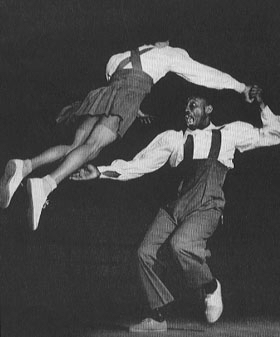
Frankie Manning, Our Hero!
Frankie Manning was the Dean of the Lindy Hoppers
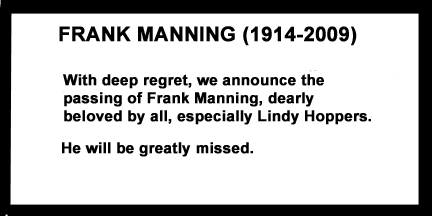
Frankie Manning has passed away but his spirit lingers on. Here is an article that appeared in the New York Times on May 22, 2009. I don't know if it was "Saints" that marched behind Frankie's funeral band, but we were proud to be "in that number," something that I will never forget.
Honoring the Man Who Helped Make the Lindy Hop
"A-one, a-two, a-you know what to do. "
And they certainly did: they danced the Lindy hop, and danced again. Right there in the sacred aisles of the Fifth Avenue Presbyterian Church in Manhattan. They were incited by a series of speakers who repeated this signature catch phrase of the dance legend Frankie Manning during a rollicking three-hour memorial service in his honor Friday, attended by 1,400 Lindy-crazed acolytes who had journeyed there from 33 countries.
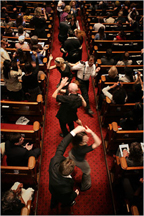
Michael Appleton for The New York Times
Rhythm, not sorrow, was the order of the day at a memorial held on Friday for the dance legend Frankie Manning at the Fifth Avenue Presbyterian in Manhattan.
Then the celebrants erupted through the church doors onto Fifth Avenue in a New Orleans-style processional — clapping, dancing and sporting umbrellas in the May sun as they were led by a jazz band in singing "Down by the Riverside" and "When the Saints Go Marching In." They ended up, still sashaying, by the Naumburg Bandshell in Central Park for an afternoon of Lindy competitions.
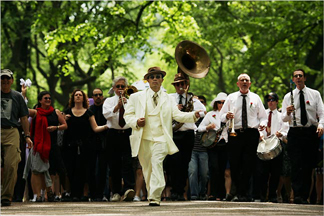
Michael Appleton for The New York Times
A procession was held afterward through Central Park.
The memorial was the centerpiece of a five-day celebration of the life of Mr. Manning, who died in April at the age of 94. A proselytizer, teacher and choreographer, Mr. Manning was called the Ambassador of the Lindy Hop and the Master of Swing. He went from the Depression-era Savoy Ballroom in Harlem to Hollywood and Broadway, where he shared a Tony Award in 1989 for best choreography in "Black and Blue."
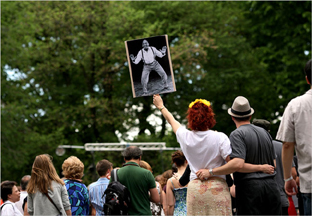
Michael Appleton for The New York Times
Mr. Manning’s photograph was held aloft at the Central Park celebration.
"Frankie was the living symbol of the Lindy hop," said Marv Kellerman, 62, a retired teacher from Kenosha, Wis., who arrived Thursday for the events with a clutch of avid Lindy hoppers from America’s Dairyland. The five-day remembrance — for which 2,100 people registered, paying $199 for scheduled events — was originally intended as a 95th birthday celebration for Mr. Manning, whose death reconfigured the gathering as an homage to his life. Several spoke to Mr. Manning as if he were present. "I want to say hello to Frankie and not goodbye," said the producer George Avakian. And Deborah Manning, his daughter-in-law, said, "He’s up there dancing and singing." At times, irrepressible Lindyphiles danced in the church aisles. The memorial was punctuated by laughter, applause and even cheers, not to mention syncopated hand-clapping and choruses of amens. "If you want to get up and dance — dance," said the Rev. Dr. Scott Black Johnston, the senior pastor of the church. "This is a temple of celebration." Soon he took his own advice — Lindy-ing in the pulpit with some of the revelers.
Mr. Manning "was a living legend but he never acted like one," said Lennart Westerlund, a Swedish Lindy popularizer who met Mr. Manning 25 years ago. Mr. Manning first greeted him with a dinner of meatballs adorned with tiny Swedish flags. Mr. Manning was nicknamed "Musclehead" for his powerfully quick acrobatic style, as he hurled his swing partners through show-stopping athletic sequences — and sometimes through space, in what was called his "aerial" or "air step." Mr. Manning appeared in such Hollywood musicals as "Radio City Revels" (1938) and "Hellzapoppin’ " (1941), before serving in the Army in World War II. After the Lindy craze crashed, Mr. Manning found employment as a post office clerk. But by the time he retired in 1986, a new generation of American and European enthusiasts had rediscovered not only the Lindy, but also Mr. Manning.
He soon became a dapper, charismatic Pied Piper of the Lindy, which he described as "a series of three-minute romances," insisting that it was a social leveler that swept aside ethnic, class and gender traditions. Many said Mr. Manning’s stamina hardly attenuated with age. "The first time you saw him, he appeared to be an old man," recalled Silvia Palazzolo, 35, an accountant from Genoa, Italy. "Then the music started and he was 18 years old." In 1999, Mr. Manning danced with 85 successive partners at the Roseland Ballroom to celebrate his 85th birthday. It was satisfying, said Alan Sugarman, a producer of that event, since in 1935 Mr. Manning had been excluded from the hall because he was black.. "In 1999, Roseland apologized and put Frankie’s dance shoes on their wall of fame," he said.
During the balmy afternoon Lindy hoppers at the bandshell partied on, continuing the five-day celebration, featuring 15 bands and some 70 events. Many described the Lindy as seductive. Hazel Squire, 46, an information-technology manager from London, said, "I dance as much as possible — one or two times a week." Lisa Erickson, 31, a food product developer from Stockholm who had flown in for the events with a Swedish contingent of 40 Lindy lovers, said: "It’s not just the dance, It’s the music — the people. The whole atmosphere is a joy."
Biography of Frankie Manning
(This biography of Frankie Manning is taken from Margaret Batiuchok's Masters thesis on Lindy Hop on the US Swing Dance Server)
Frank Manning was one of Whitey's Lindy Hoppers from 1936 to 1941. Frank began dancing as a child, and by the time he was sixteen he was winning contests and almost professional. He came in third place in the first Harvest Moon Ball in 1936, and second place in the one the following year. He became Whitey's right hand man and chief choreographer and with Whitey's group toured the world and appeared in the films Hellzapoppin'' and the Marx Brothers' A Day at the Races in the 1940's.
During the war he put together shows to entertain the troops. After the war he toured the U.S. with his own group, The Congaroos, with the bands of Cab Calloway, Duke Ellington, and Count Basie. Frank originated many of the aerial steps by taking floor steps one step further. He originated "the tops," freezing in the middle of a number and then continuing on, to the song "Posin'." He also did the first Lindy routine which was danced by more than one couple doing the same steps at the same time. He is a winner of the Tony Award for Black & Blue.
He believes in seeing a step and changing it and taking it one step further. He doesn't believe in a right and a wrong way to do a step. When choreographing, he choreographed for each individual dancer and let each couple do their own special steps instead of forcing everyone to be the same. Frank Manning has an incredible amount of energy and a great love for dancing. He is threatened by no one. He is open and generous and takes everyone in without criticism. Frank is a natural performer. When he dances everybody watches. His early performing experience, his active mind, and his years of dancing give him a wealth of material to draw upon. He constantly creates newroutines and uses them as little sections in his social dancing. Performing and social dancing are one and the same to him. He'll call out "points" or "tango dip," and he and his partner will go into a 16-count sequence they have memorized. His repertoire is full of such sequences and they are interesting to watch. Steady partners get to know more and more of these routines, which he may call out at any point in the dance that he wishes. It is like writing in phrases instead of words. He uses the basics as linking steps. Frank moves across the room - forward, backwards, side by side, circling, circling backwards, hopping, skipping - with a powerful energy that conquers the whole room. His posture is generally low to the floor, his head bowed and his left leg kicking away so that his whole torso is parallel- to the floor at times. His style is bouncy, in the vertical-plane. (None of the four I'm describing here uses a sidewards rocking of the torso. Most hold their torsos calm, isolating them from their hips and legs. Frankie does a slight torso rock, but not like you see beginners or 50's rock'n'rollers do.) Frank uses a double bounce, a bounce on every beat of the music. He dances with a strong lead; the woman has no option but to follow, or be wrong. He dances to the beat of the music and to the mood of the music. His posture changes with his interpretation of the mood. He dances saying something with his movements, something witty, some dance talk - a variation on the rhythm, doing a number of swing-outs with different syncopations at the end of each one, or a new posture, or facing or way of coming in. He is innovative and always thinking and playing around.
This man has more energy and enjoyment of life than most twenty-year-olds. His personality and sense of humor exude from him as he dances, but also as he talks and laughs and goes through his animated antic. He is a publlc, visible, and generous man, and this comes out in his dancing, through a generous use of space and a generous use of his smile, which beams for miles and miles.
(This article is from the Library of Congress Website)
1930S DANCE REVIVAL: FRANKIE MANNING PERFORMS THE "LINDY HOP"
"Don't think about getting old," said energetic, 80-year-old dancer Frankie Manning, who effortlessly demonstrated the "Lindy Hop" and other dance styles, including tap and swing, to an overflow audience in the Mumford Room on May 17.
The Library's American Folklife Center presented Mr. Manning as part of the 1995 American Folklife Center Neptune Plaza Concert Series. The event was held indoors because of rain. Washington-area radio personality Dick Spottswood from American University's WAMU 88.5 FM introduced Mr. Manning to the audience.
Mr. Manning gained fame for adding acrobatic "air steps" to the "Lindy Hop," or jitterbug dance style at Harlem's Savoy Ballroom in the 1930s, when he hoisted a female partner on his back and then flipped her over his head to land facing him.
During the hour long performance, Mr. Manning explained the history behind each dance number. Dressed in a black body suit and red shirt, Mr. Manning was joined on the dance floor by his son, Charles "Chazz" Young, and two women, Mickey Davidson and Debbie Williams.
Mr. Manning demonstrated a "flying Charleston," first kidding that he could not do that type of dancing anymore, then performing it with ease by doing a high kick forward and a low kick backward. The audience gasped in astonishment.
A third number, "Tribute to Chorus Girls," was performed by Ms. Davidson and Ms. Williams. They mirrored each other's movements as if they were in a chorus line. "Chorus girls were treated special during vaudeville," said Mr. Manning. "Each theater on the circuit, New York, Baltimore, Washington, D.C., and Philadelphia, had chorus girls; Josephine Baker, Lena Horn and Ethel Waters got their starts as chorus girls."
A fourth number, "The Shim Sham," was a father-and-son duet choreographed by Mr. Young to the tune of "'Tain't What You Do." The numbers were performed to the music of Brooks Tegler's Hot Jazz. Members of the band were: John Jensen on trombone, Tom Mitchell on guitar, John Previti on bass, Robert Redd on piano, Al Seibert on tenor sax and Brooks Tegler on drums.
A tap trio performed the fifth number, "Swing." According to Mr. Manning, the swing can be used in combination with other dance styles, including the mambo. The last number, "Woodside Hotel," was dedicated to a New York hotel of the same name, where Mr. Manning spent much of his youth listening to the jam sessions of Tommy Dorsey, Coleman Hawkins, Benny Goodman and Count Basie.
Mr. Manning was born in 1914 in Jacksonville, Fla. At age 3, he moved to Harlem with his mother, who was a dancer. He grew up in the Swing Era and became part of its history by dancing to the music of the 1930s and 1940s.
The name Lindy Hop emerged shortly after Charles Lindbergh completed his trans-Atlantic flight in 1927. Shorty Snowden, a dancer at the time, coined the phrase during a dance marathon in Manhattan. It was later at the Savoy Ballroom's weekly dance contests that Snowden's style of Lindy Hop, in which the body is held upright as the dancer executes intricate footwork, was soon overshadowed by Mr. Manning's more acrobatic style.
In 1934 Mr. Manning was a dancer and the chief choreographer for the original "Whitey's Lindy Hoppers," the professional troupe organized by Herbert "Whitey" White, a bouncer at the Savoy Ballroom. Mr. Manning also performed in several films, including the Marx Brothers' "A Day at the Races" in 1937 and "Hellzapoppin'," before touring the world with jazz artists Ethel Waters, Ella Fitzgerald, Sarah Vaughan, Bill "Bojangles" Robinson and Cab Calloway.
While dancing in London in 1937, Mr. Manning gave a command performance for King George VI. By 1943 a Life magazine cover story proclaimed the Lindy Hop as "America's national dance" and "this country's only native and original dance form" except for tap dancing.
Whitey's Lindy Hoppers disbanded during World War II, and Mr. Manning joined the U.S. Army. But upon his release in 1947, Mr. Manning formed his own dance troupe, "The Congaroos Dancers." They appeared on the "Milton Berle Show," and toured with Nat "King" Cole, Tony Bennett, Dizzy Gillespie, Martha Raye and Sammy Davis Jr.
As popular taste turned to rock 'n' roll in the 1950s, Mr. Manning settled down to family life. A revival of swing dancing in the mid- 1980s sparked a renewed interest, which has sent Mr. Manning throughout the world once again, leading workshops and lectures and developing choreography for groups such as the Alvin Ailey American Dance Theater and Rhythm Hot Shot of Sweden.
Among national recognitions he has received, Mr. Manning was profiled on the ABC prime-time news program, "20/20"; he received a Tony Award for best choreography in the Broadway hit musical "Black and Blue"; and choreographed "Stompin' at the Savoy," an NBC made-for-television movie directed by Debbie Allen. Recently, he was involved in the two- part TV film on American social dancing called "Gotta Dance!"
Before the concert ended, Thea Austen, public events
coordinator in the American Folklife Center, announced that Mr.
Manning would be celebrating his 81st birthday in a couple of
days. The audience responded by singing "Happy
Birthday" to Mr. Manning while he was presented with a sweet
potato pie.
---Carroll L. Johnson
Carroll Johnson is a program specialist in the Cultural Affairs Division of the Library of Congress.

Frankie Manning
Dancing with #76, Carole Berghers, at Mobtown '98
Frank Benjamin Manning passed away in the morning of April 27, 2009, just shy of his 95th birthday
Counter for the ENTIRE Website
Home | About Lindy | Last Week's Reviews | Upcoming Events | 1940s Collectibles
The Guide - Establishments - Travel - Accessories
Music | Links | Photo Gallery | Extras | Contact